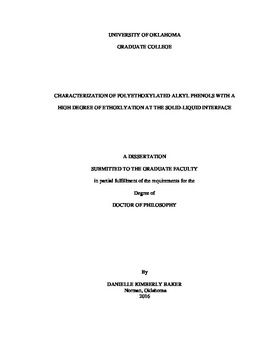| dc.description.abstract | Fully characterizing the behavior of a surfactant, from the mechanism of adsorption to the formation of micelles, is vital when taking the surfactant out of the lab and into the real world. The critical micelle concentration, cloud point, and mechanism of adsorption are only a few aspects of a nonionic surfactant that must be understood. For nonionic surfactant solutions, the solution properties can change depending on the system temperature, salt concentration, salt type, etc. This dissertation focuses on the adsorption of high polyethoxylated alkyl phenols, more than 25 ethylene oxide units, on the hydrophilic silica surface and how environmental conditions affect the surfactant adsorption at the solid-liquid interface. The effects of ions of different salts on the adsorption densities and the shape of developed adsorption isotherms are related to the Hofmeister series. Depending on the ions present in solution, the maximum adsorption density is shown to increase or decrease in accordance with the Hofmeister series’s classification of ion as salting in or salting out. The salting out effect of sodium chloride causing an increase in adsorption density as well as a decrease in nonionic surfactant cloud points is examined as a fraction fluid, containing a high polyethoxylated alky phenol, travels through a packed ground shale or sand column. The effect of sodium chloride on a select few ionic surfactants traveling through the same packed ground shale or sand column is also analyzed. For the high polyethoxylated alky phenols, the formation of a coacervate hindered the surfactant migrating to the end of the column. For the ionic surfactants, the migration to the end of the packed column varied depending on the surfactant’s salt and temperature tolerance. Lastly, evidence is given with UV, quartz crystal microbalance, and ellipsometry analysis for a different mechanisms of adsorption for polyethoxylated alky phenols with a high degree of ethoxylation versus a low degree of ethoxylation. | en_US |
